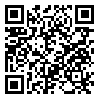1. [1] Altman, M,. (1994), "Corporate distress diagnosis: Comparisons using linear discriminant analysis and neural networks (the Italian experience)", Journal of Banking and Finance, Vol: 18, PP: 505-529. [
DOI:10.1016/0378-4266(94)90007-8]
2. [2] Cybinski, P,. (2010), "Discription, Explanation, Prediction, the Evolution of Bankruptcy Studies", Faculty of International Business and Politics, Griffin University, Brisbane, Vol:27,No:4, PP:29-44. [
DOI:10.1108/03074350110767123]
3. [3] Anandarajan, M, and et al,.(Jun 2011), "Bankruptcy Prediction of Financially Stressed Firms: An Examination of the Predictive Accuracy of Artificial Neural Networks", International Journal of Intelligent Systems in Accounting,Finance and Managment, Vol: 10, No: 2, , PP: 69-81. [
DOI:10.1002/isaf.199]
4. [4] Jianqiang, ZH., Xiaolin, G,. Comparison research on text preprocessing methods on Twitter sentiment analysis, IEEE Access 5, 2870-2879, 2017. [
DOI:10.1109/ACCESS.2017.2672677]
5. [5] Proksch, s., et al,. Multilingual sentiment analysis: A new approach to measuring conflict in legislative speeches, Legislative Studies Quarterly 44 (1), 97-131, 2019. [
DOI:10.1111/lsq.12218]
6. [6] Luo, X., et al,. User behavior prediction in social networks using weighted extreme learning machine with distribution optimization, Future Generation Computer Systems 93, 1023-1035, 2019. [
DOI:10.1016/j.future.2018.04.085]
7. [7] Mohbey, K., Multi-class approach for user behavior prediction using deep learning framework on twitter election dataset, Journal of data, Information and management 2 (1), 1-14, 2020. [
DOI:10.1007/s42488-019-00013-y]
8. [8] Bao, B., Chen, L., Cui, P., User behavior and user experience analysis for social network services, Wireless Networks, 1-7,2020. [
DOI:10.1007/s11276-019-02233-x]
9. [9] Huang, L., et al., User behavior analysis and video popularity prediction on a large-scale vod system, ACM Transactions on Multimedia Computing, Communications, and Applications (TOMM) 14 (3s), 1-24, 2018. [
DOI:10.1145/3226035]
10. [10] Shaimaa, M., et al., Classification and prediction of opinion mining in social networks data, International Journal of Computers and Information, 2020.
11. [11] Sheng, X, X. Wu, Y. Luo, A Novel Text Mining Algorithm based on Deep Neural Network, IEEE, 2018.
12. [12] Chen, Z, B.Liu, Mining topics in documents : standing on the shoulders of big data, in: Proceedings of the 20thACMSIGKDDInternational Conference on Knowledge Discovery and Data Mining,ACM ,pp.1116-1125, 2020.
13. [13] Jawahar, G., Sagot, B., & Seddah, D. (2019, July). What does BERT learn about the structure of language? [
DOI:10.18653/v1/P19-1356]
14. [14] [14] S. Gonzalez-Carvajal and E. C. Garrido-Merch ' an, "Comparing BERT ' against traditional machine learning text classification," ArXiv preprint, 2021, arXiv:2005.13012
15. [15] M.A. Al-Garadi, YC. Yang, H. Cai, Y. Ruan, K. O'Connor, G.-H. Graciela et al., "Text classification models for the automatic detection of nonmedical prescription medication use from social media," BMC Med Inform Decis Mak, 2021, pp. 21-27, doi: 10.1186/s12911-021-01394-0 [
DOI:10.1186/s12911-021-01394-0] [
PMID] [
]
16. [16] M., Pota, M. Ventura,R. Catelli and M. Esposito, "An effective BERTbased pipeline for Twitter sentiment analysis: A case study in Italian," Sensors, 2021, vol. 21, pp. 1-133, doi:10.3390/s21010133 [
DOI:10.3390/s21010133] [
PMID] [
]
17. [17] Jacob Devlin, Ming-Wei Chang, Kenton Lee, and Kristina Toutanova. BERT: pre-training of deep bidirectional transformers for language understanding. CoRR,abs/1810.04805, 2018.
18. [18] Ashish Vaswani, Noam Shazeer, Niki Parmar, Jakob Uszkoreit, Llion Jones, Aidan N Gomez, Ł ukasz Kaiser, and Illia Polosukhin. Attention is all you need. In I. Guyon, U. V. Luxburg, S. Bengio, H. Wallach, R. Fergus, S. Vishwanathan,and R. Garnett, editors, Advances in Neural Information Processing Systems 30, pages 5998-6008. Curran Associates, Inc., 2017.



